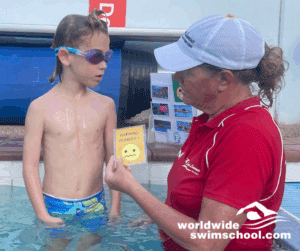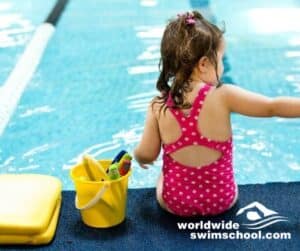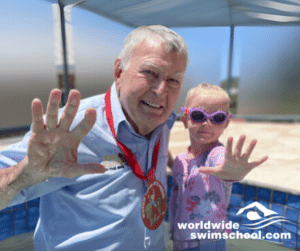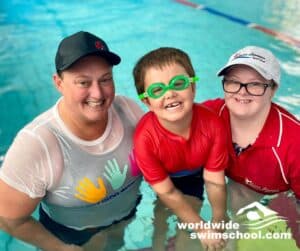Time in the pool outside of swimming lessons is important in learning how to teach kids to swim at home. It is conducive to your child’s learning, progression and development in the water. It is also as important to his/her actual learn to swim lesson. As swimming teachers, we know that the hardest child to teach any skill or activity may indeed be your own. I often compare it to taking your first driving lesson with your partner.
So how do we do it, I hear you ask? There are many approaches you can take, but we find the most important one that never fails is simply to make it FUN. The fun never fails. Fun in the pool with your child in a less structured environment will increase independence. It will also help your child develop a deeper respect for the water. We recommend the use of incentives, such as toys or coloured balls.
You know your child better than anyone else so don’t hesitate in using whatever you think might work for him/her. Weather and temperature are factors to take into consideration when getting the most out of your time in the water. We recommend the following activities will help when it comes to learning how to teach kids to swim at home.
Controlled Kicks
When you start to teach kids to swim at home, you can assist your child with their kicking. This will give them a better understanding of movement and propulsion in the water. Place your child on their tummy and bring their arms around your neck (cuddling you). Then, by placing your thumbs on their calf muscles, you can gently manipulate fast, little kicks on the top of the water. This activity is called “cuddle kicks”.
You can also manipulate the legs by holding them in a sitting position. With their back resting against your tummy, manipulate their kicking legs on top of the water and walking forward. These are known as soccer kicks. By manipulating your child’s kicking legs you are keeping the kick under control and restricting the depth of the kick. Essentially, you are working towards gaining nice long legs, pointed toes and floppy ankles.
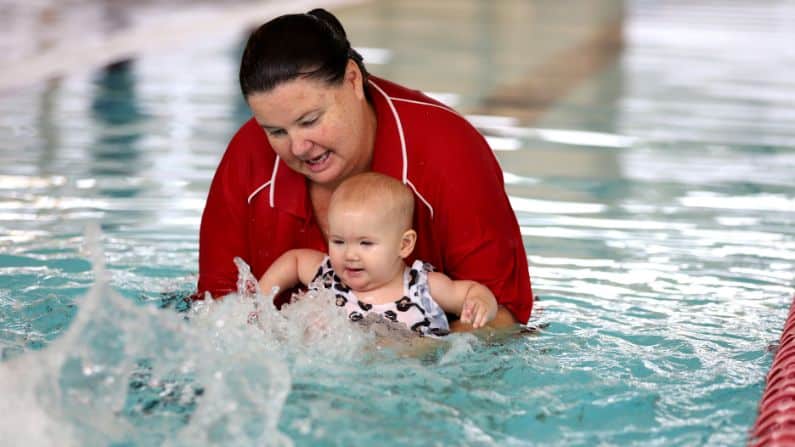
You can make a game out of it by throwing a coloured ball to the other side and chasing it. Kicking legs can also be practiced on a shallow ledge within the pool if there is one available. Again, the ledge controls the depth of the kick and therefore restricts the legs from bending too much. Working towards simple goals of kicking for up to 10 seconds can be a fun way to practice ledge kicking.
Back Floating
Another step to teach kids to swim at home is back floating, which is a valuable skill at all ages. This is usually easy to achieve under the age of six months because they are a little less mobile. As they learn to sit up independently, being on their back is no longer a preferable position for them. By starting with assisted back floats, you can remain close to your child and maintain face-to-face contact. Do not ever force a child on their back against their will. It can scare them and make your job of teaching them so much harder in the long run.
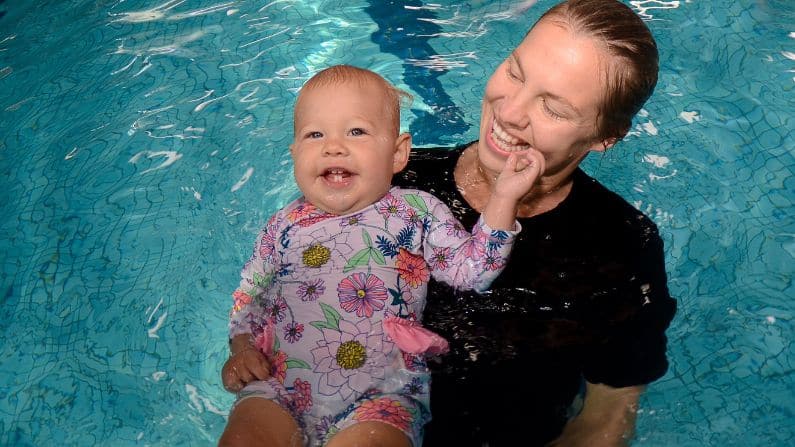
Start teaching back floats by standing behind your child and placing the back of their head on your shoulder and walking backwards. Sometimes singing or talking to your child during this activity can distract your child and take your child’s mind off the activity at hand. As they get more comfortable, you can progress to supporting their neck with one hand and place your other hand under their back.
Working Towards Relaxation
The aim here is to reach a point of relaxation where you can slowly work towards removing all hand contact with your child. We encourage saying things like “eyes to the sky/roof, keep your tummy nice and dry, lie on top of the water”.
If you have access to a kickboard, by all means, use it as an aid where it is placed on top of their tummy and encourage them to squeeze the board on their tummy. Set small goals as they become more fearless and confident, give them a goal of three seconds to start with. Increase this as confidence grows.
Monkeys on the Wall
Teaching monkeys is an extremely important safety skill for children to be able to move from one area to another. It is important that your child has mastered a strong hold on the wall; this can be at a pool with a deck level wall or on a high wall, as no two pools are generally ever the same. This will improve strength and as their grip improves they should practice independently for short periods of time. To learn monkeys, we simply teach them to move along the wall using a hand over hand movement.
Again, this may require some assistance from you and as always, toys are a great incentive for encouraging the kids to move towards. Place the toys sporadically along the wall. As your child advances with this skill and improves, it is important that you always remain close and within arms reach.
Turn Arounds
Another step to teach kids to swim at home is the skill of turning around under the water, which is an essential skill for any child to learn and perfect. We encourage this to be taught as soon as your child has developed good breath control. You can do this by holding your child under the arms and facing away from you. Give the trigger cue “name, ready, go”, lift and lower your child under the water and turn them back towards you, encouraging them to reach for your shirt.
It is advisable that you start with a couple of these above the water firstly, just to introduce your child to the activity and give them an idea of your expectations, and how they will move with your assistance. Remember there are many various ways in which you can practice turn arounds with your child, however, we strongly recommend that you ensure your child is competent at turning back to the wall from the side of the pool.
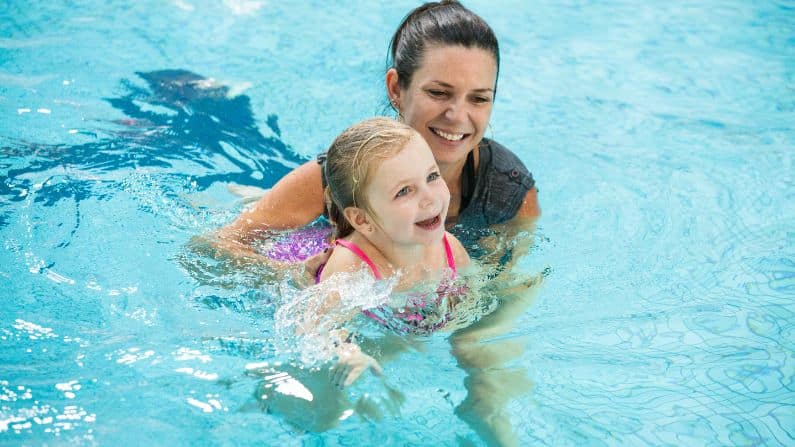
By practising these turns to both sides (turn your child to the left and then right) will discourage them from potentially developing a favourite side. This activity can turn into lots of fun but by simply adding in a song or two or by utilising a toy whereby they have to turn back (towards you or the wall) to retrieve the toy.
Independent and Explorative Play
Letting your child play independently on a ledge or in a shallow area of a pool, with some toys, can be highly beneficial and increase your child’s confidence in the water. Here, they can get a chance to make small errors and correct themselves. For example, if they fall over from a sitting position, they can right themselves or if they slip off the edge, they can turn back to the wall. I cannot stress enough how important it is to always stay close to your child at all times, regardless of any activity you do and give them the assistance if required.
Things that we as adults take for granted can be quite daunting and unfamiliar for children, as simple as walking in waist-deep water. This is something that adults are generally used to and can do with ease. However, for a toddler who may only have exposure to water during their swimming lesson once a week, they might not be used to walking and remaining balanced in waist-deep water, especially if there are a lot of pool users and movement of water.
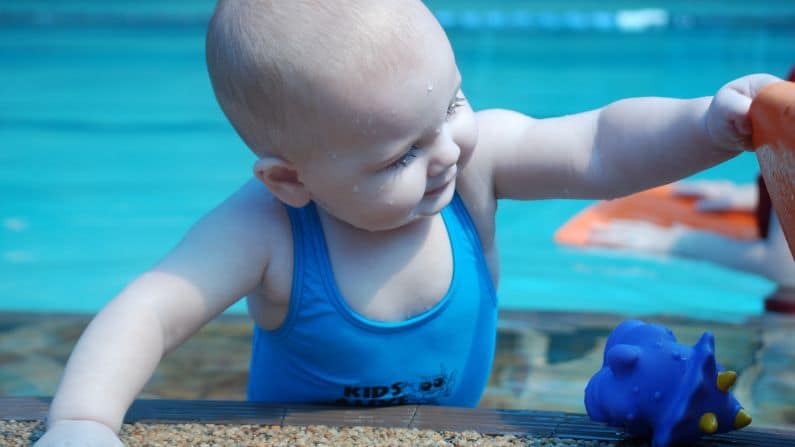
By giving children the opportunity to independently sit, play and explore in shallow water, we will not only provide them with self-control but more importantly, we will teach them respect and love of the water as they learn the difference between deep and shallow.
Swim-arounds
This activity is a great way of encouraging and progressing independent swimming and teaches children how to change direction in the water. This is something that will help your child out when you may be at a pool party or at the beach when there are other people around sharing the same body of water where they may need to manoeuvre around.
To practice this activity, we recommend starting with your back against the wall and holding your child under the arms to your side (with their back also against the wall). Giving the cue, assist them to swim in a semi-circle, around you and back to the wall on the other side. The use of a ledge or a step in the water can be really beneficial in the teaching of this skill.
You can make this activity fun by encouraging your child to swim towards an incentive such as a floaty toy or a coloured ball. As they master this with your assistance, start to encourage them to come off the ledge by themselves and kick and paddle around you. Remember to practice to both sides.
Jumping from the Side
Jumping and diving can be lots of fun for kids that are confident in shallow water. By teaching a child to jump from the ledge of the pool, we are giving them the capability to be in control and they will further develop their respect for the water and the feeling of buoyancy in deeper water. To teach your child, ensure that you have moved to a deeper section of the pool.
Get your child to sit or stand on the edge, encourage them to jump out towards you and invite them with open arms. It is important that you do not move after they have jumped as this can be detrimental to their trust, especially if it has been a process to get to this point. As they grow to love this activity and become more confident, you can start to incorporate other incentives as well as further develop their current skills and ability.

Some examples would be to include floating toys, so they would jump out, grab a toy and swim back to the ledge. Another good one is for them to practice is to jump out and swim around you and swim back to the ledge. As with all pool and aquatic environments, please stress to your child that they only practice this skill when a guardian is present in the water with them and they are invited to do so.
Independent Paddles and Kicks
Lots of manipulation for kicking legs and paddle arms is mandatory to achieve good muscle memory for independent swimming. Like everything, you will start by assisting your child and gently manipulating, if they are not yet swimming independently.
We always recommend starting small. So simply having them push off the ledge/side of the pool to you, by themselves is an achievement in itself. Make sure they are reaching for you and pulling themselves up onto your shirt, without your assistance.
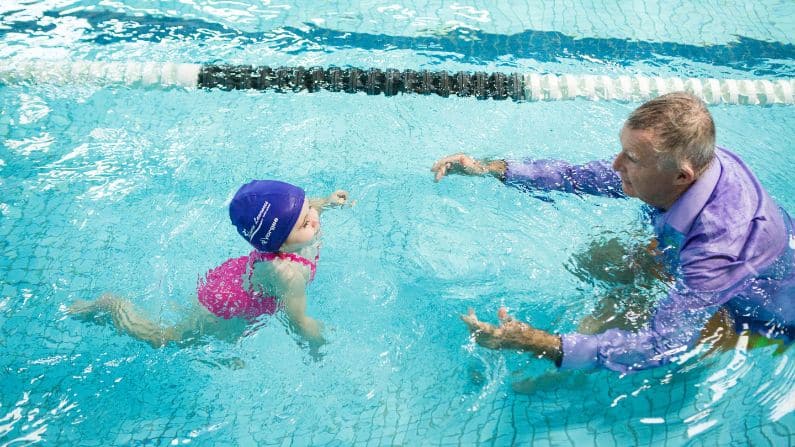
Now, you have the opportunity to reinforce the skills which they are currently working on. Practice their kicking legs in the cuddle kick position and sit them on one of your knees and manipulate the arms in a paddle motion, ensuring you are reaching the arms out long and pulling them under the water back to their hip.
Always keep their arms under the water whilst practising. Turn them to face the wall and have them push off your hands and kick and paddle back to the wall. Don’t forget to give plenty of encouragement, correction and but most importantly praise.
Swimming in Varying Depth for Objects
This is generally a good incentive activity for how to teach your kids to swim at home and for trying to get through the other activities. Kids generally love the idea of going to the bottom of the pool to get toys/objects or going on an underwater treasure hunt.
There are many benefits to be achieved from this skill. These include better breath control, increased independence, good rotation and recovery. We suggest starting small, as always, so the first time you do it, start it on a shallow ledge where the water depth is quite low.
There are a few things to consider as you vary the depth, please ensure your child has got good breath control and that they are comfortable under the water. We also need to remember that your child will be changing positions in the water, going from a floating position on top of the water into a more vertical position to retrieve the toys and recovering back into a standing vertical position.
Assisting your Child by Guiding Them
Assist your child in these processes by gently guiding them. As they become more confident, increase the depth gradually and guide your child to the toy by placing your hand between their shoulder blades. You should always guide them down at an angle rather than pushing them straight down vertically.

Again, as confidence and breath control increase, you can show them how to use their arms to pull themselves independently to the bottom. Simply place the arms in front and pulling the arms down to the side, will assist in the change of body position. You can also give verbal suggestions like “do a handstand under the water” or “push your head to the bottom and stick your feet up to the sky/roof”.
Climbing out of the Pool
As soon as children learn how to pull themselves up into the standing position, they also start to learn how to climb. These motor skills are generally adapted from land to water and this is where we step in and assist the little ones in learning how to climb out of the pool. This skill may seem somewhat simple but it is just as important as all the other skills listed above.
Initially, when teaching little ones to climb out, you must encourage them to pull up using their elbows to get their tummy out of the water and their knees to complete the manoeuvre. You may need to give some assistance when first learning this skill. The great thing about this activity is that you can incorporate it with many of the activities above. For example, jump in, turn around, kick and paddle back to the wall and climb out.
Results of Climbing out of the Pool
This results in your child practising the skill repetitively which ultimately results in your child becoming stronger and more familiar with this very important skill. As adults, we need to remember that every pool has its own style, various types of entries and different walls with various heights and water levels. Don’t forget to take these differences into account when you do visit a different pool and always use the verbal cue of “elbow, elbow, tummy, knee” when your child is climbing out of the pool.
We sincerely hope that we can help you help your child in becoming more confident in and around the water from the various activities above. This will be achievable provided that your child has supervised and regular exposure to an aquatic environment with your assistance. Please remember that no matter how confident you may think your child is, you should always be no further than an arm’s length away from your child. These steps and guidelines above are also best achieved when practised with a fun and loving approach.
We have all the tools to help you with our How to Teach Kids to Swim at Home pack. Join our community to keep up to date with latest offers, article and more.
Kids Alive Do the Five give you fun resources for children an parent to teach water safety around home.


